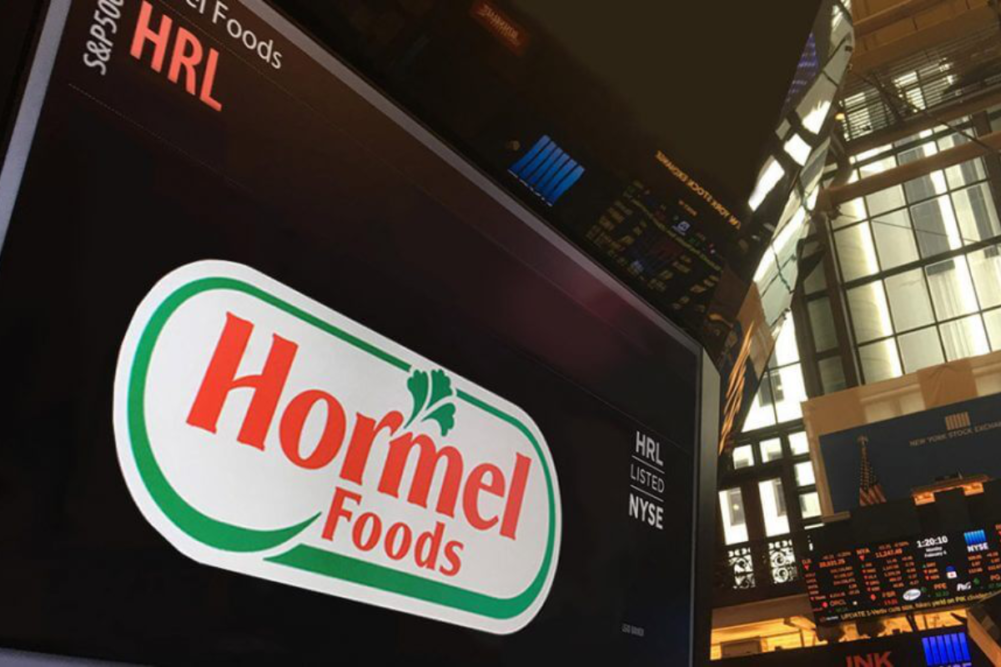AUSTIN, MINN. – Foodservice category weakness and costs associated with the coronavirus (COVID-19) ate into Hormel Foods Corp.’s profitability during the third quarter of fiscal 2020. Tailwinds from strong sales at supermarkets pushed quarterly sales to a record high.
Net income for the quarter ended July 26 was $203 million, equal to 38¢ per share on the common stock, and a slight increase over the same period of the previous year when the company earned $200 million, or 37¢ per share.
Sales for the quarter rose to $2.4 billion from $2.3 billion the year before.
Total sales to retail rose 19% during the quarter, said James P. Snee, chairman, president and chief executive officer, during an Aug. 25 conference call to discuss results.
“According to IRI, during the quarter, we grew share in approximately 60% of the categories where we are the No. 1 or No. 2 brand,” he said. “We also saw tremendous growth in e-commerce, including direct-to-customer and online grocery pickup and delivery.”
But impacting performance was a 19% decline in foodservice sales when compared with the third quarter of fiscal 2019.
“Our foodservice business, which represents approximately 40% of Refrigerated Foods (business unit) sales saw double-digit declines during the quarter,” Mr. Snee said. “However, we are very confident that as the foodservice industry recovers, our product lines featuring pre-cooked, pre-sliced and pre-marinated products will thrive as operators look to simplify preparation and reduce handling of products.”
Mr. Snee added that he expects foodservice category dynamics during the fourth quarter to mirror the trends that took place during the third quarter.
“There remains a high level of uncertainty as to how quickly segments in the foodservice industry, such as casual dining, lodging and schools will reopen,” he said. “Therefore, we expect our foodservice business will show declines in the fourth quarter.”
The company is anticipating total costs associated with COVID-19 for fiscal 2020 to be between $80 million and $100 million. During the third quarter costs were approximately $40 million, with most going to employee bonuses, safety measures and lower production volumes. Costs during the fourth quarter are forecast in the range of $20 million to $40 million.
Hormel’s Refrigerated Foods business unit, the company’s largest, had a sales increase of 5% during the quarter to $1.4 billion. Volume rose 8%, but segment profit fell 11% due to lower foodservice sales. Brands that performed well during the quarter included Applegate, Hormel Black Label and Columbus.
The Grocery Products business unit had a strong quarter, with volume up 7% and segment profitability up 36% compared with the previous year. Quarterly sales totaled $581 million and operating profit reached $80 million.
“Similar to the second quarter, we saw exceptional growth from nearly every brand especially brands such as Spam, Skippy, Herdez, Hormel Compleats and Dinty Moore,” Mr. Snee said. “One brand, which has seen a resurgence of demand is Skippy. While the entire peanut butter category has seen growth as kids stay at home, the Skippy brand has thrived and outpaced the competition.”
Jennie-O Turkey Store sales fell 4% to $287 million and segment profit fell 67% to $7 million.
“While we saw strong growth in our retail business, it was not able to offset declines in our foodservice, commodity and whole bird businesses,” Mr. Snee said. “Segment profit decreased 67%, driven exclusively by the impact from three plant pauses and incremental supply chain costs related to COVID-19 safety measures.
“This is an important distinction as it speaks to how the earnings strength in our retail business was able to offset the declines in our foodservice business. We were making excellent progress in many areas, but the cascading impact of three plant pauses throughout our vertically integrated supply chain had an outsized impact on profitability this quarter.”
The company did not offer guidance, but did indicate fourth-quarter market dynamics may mirror the third quarter.
“We are actively addressing two areas of our business,” Mr. Snee said. “First, while we saw an improvement in the third quarter, our foodservice business was still behind last year, which is a trend we expect to continue into the fourth quarter. I’m proud of the work our foodservice teams are doing to find unique solutions to support our distributors and operators. It is also encouraging to see growth from other channels and businesses offset declines in the foodservice channel.
“Second, our plant professionals have done heroic work to meet the high level of demand we are seeing across our business. In most businesses we are producing more product than we ever have, which is quite an accomplishment. However, in some key categories, the ongoing increased demand and impact of COVID-19 in our manufacturing facilities has forced our supply chain to find alternate solutions to increase production, including relying on our network of trusted co-manufacturing partners.
“In the fourth quarter, we expect factors such as limited labor availability, production inefficiencies due to COVID-19 safety measures and unseasonably low levels of inventory to challenge our ability to meet the increased demand for certain products.”





